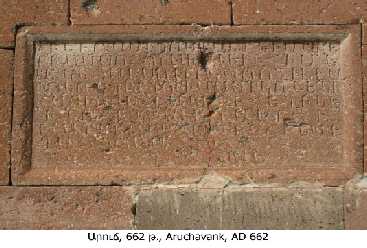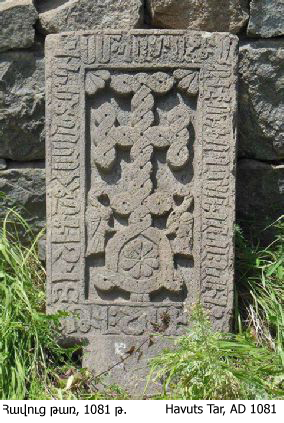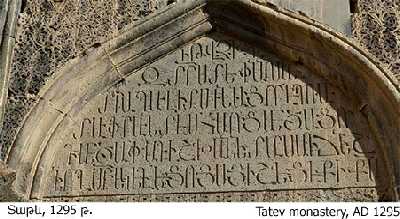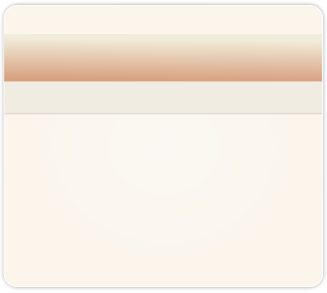Armenian Lithography (inscriptions)
 The Lithography ( inscriptions ) from the middle ages are an irreplaceable, primary source for the history of Armenia in the Middle Ages. Acknowledging their importance, many among the Armenian thinkers/writers of the time, of whom are Stepanos Orbelyan ( 13th, century ), Zakaria Kanakertsi ( 17th, century ), have used lithography in their histographical works, and as for Yessayi Hasan - Djalalian, Catholicos of Aghvank, he has collected and completed a book especially, on the lithography in the Khatchen ( Artsakh ) area ( in 1718 ).
The Lithography ( inscriptions ) from the middle ages are an irreplaceable, primary source for the history of Armenia in the Middle Ages. Acknowledging their importance, many among the Armenian thinkers/writers of the time, of whom are Stepanos Orbelyan ( 13th, century ), Zakaria Kanakertsi ( 17th, century ), have used lithography in their histographical works, and as for Yessayi Hasan - Djalalian, Catholicos of Aghvank, he has collected and completed a book especially, on the lithography in the Khatchen ( Artsakh ) area ( in 1718 ). Early, in the 19th, century, upon the encouragement by the Catholicos Nerses Ashtaragetsi, the lithography collection and documentation was greatly, invigorated. And since, then, studies/research of travel - topographic - informative nature have been published. In this respect, the valuable works of many, still present a contemporary scientific value, notably, the works of Bishop Hovhannes Shahkhatounyants, Father Nerses Sarkisian, Sarkis Djalaliants, Bishop Magar Barkhoutaryants, Archbishop Apel Mkhitaryants, Father Levon Alishan, and others.
Early, in the 19th, century, upon the encouragement by the Catholicos Nerses Ashtaragetsi, the lithography collection and documentation was greatly, invigorated. And since, then, studies/research of travel - topographic - informative nature have been published. In this respect, the valuable works of many, still present a contemporary scientific value, notably, the works of Bishop Hovhannes Shahkhatounyants, Father Nerses Sarkisian, Sarkis Djalaliants, Bishop Magar Barkhoutaryants, Archbishop Apel Mkhitaryants, Father Levon Alishan, and others.
However, the burden of organizing, development of modern implementation methods for collection, and documentation of the Armenian Lithography laid on Nicholas Marr and his disciple Hovsep Orpeli. The later, had participated in the archeological excavations in Ani, during which he collected/documented the lithographic treasures/ inscriptions of the city, later, they were summarized in the first edition of a book series called “ Armenian Lithography Corps “, edited by Setrag Barkhoutarian. The later was destined to continue and further develop his predecessors’ mission, which led him to the publication of the II - V editions of the “ Armenian Lithography Corps“, series ( IV - V editions were published posthumously/after his death, and some are still unpublished ). Setrag Barkhoutaryan, headed the department of Armenian Lithography in the National Sciences Academy of the Republic of Armenia, since it was established in 1959. At the present, the department is headed by Gagik Sargsyan. Roughly, 9 editions were published, and a few more are not published , yet.
The Armenian Lapidary are grouped by content, as follows:
A - Construction, certificates/certification
B - Doners / Benefactors
C - Legal / Permits / Grants
D - Memorial, including Khatchkars
E - Tombstones
F - Miscellaneous reports / inscriptions
 The most significant are the walls or entrances and the top part of the windows in the churches , of course , they are the most prevalent, they are of charitable nature, revealing details about the construction and certificates , which are mainly distinguished by their proportional harmony and skillful carvings. The memorials are usually short, found mainly on the Khatchkars and the tombstones/ monuments in the cemeteries. Lithography comes also in the abbreviated or embedded forms of writing, usually in brief notes.. The implemented etching methods vary, some are drilled into the stone, others are embossed and yet others convexed, while many others are garnished.
The most significant are the walls or entrances and the top part of the windows in the churches , of course , they are the most prevalent, they are of charitable nature, revealing details about the construction and certificates , which are mainly distinguished by their proportional harmony and skillful carvings. The memorials are usually short, found mainly on the Khatchkars and the tombstones/ monuments in the cemeteries. Lithography comes also in the abbreviated or embedded forms of writing, usually in brief notes.. The implemented etching methods vary, some are drilled into the stone, others are embossed and yet others convexed, while many others are garnished.

















